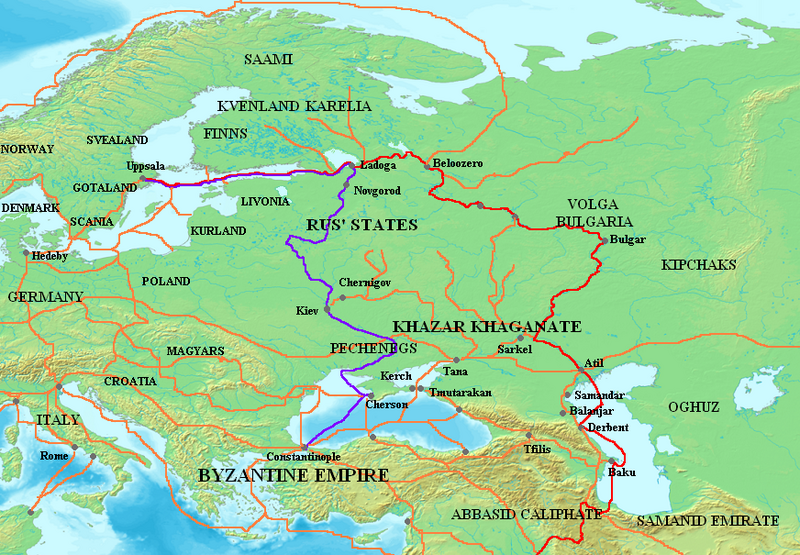ფაილი:Varangian routes.png

ზომა წინასწარი გადახედვისას: 800 × 555 პიქსელი. სხვა გაფართოება: 320 × 222 პიქსელი | 640 × 444 პიქსელი | 872 × 605 პიქსელი.
თავდაპირველი ფაილი ((872 × 605 პიქსელი, ფაილის ზომა: 859 კბ, MIME ტიპი: image/png))
ფაილის ისტორია
დააწკაპუნეთ თარიღზე/დროზე ფაილის დასათვალიერებლად, როგორც ის მაშინ გამოიყურებოდა.
| თარიღი/დრო | მინიატიურა | ზომები | მომხმარებელი | შენიშვნა | |
|---|---|---|---|---|---|
| მიმდინარე | 11:29, 3 ოქტომბერი 2023 |  | 872×605 (859 კბ) | OrionNimrod | Restore original: "Wallachians" added by Romanian user, however it was no Wallachia in the 8-11th c: British historian, Martyn Rady - Nobility, land and service in medieval Hungary (p91–93): the sources before the 13th century do not contain references to Vlachs anywhere in Hungary and Transylvania or in Wallachia. Byzantine sources mentioned Vlachs all deep in the Balcan. Also map should make by academic historians not by personal POV. |
| 18:23, 16 აგვისტო 2023 |  | 872×605 (799 კბ) | Claude Zygiel | In one hand there are Byzantine sources which mention the Vlachs, secondly it is not because other sources do not mention them that they did not exist. In the other hand, the Hungarian theory which affirms that "the absence of proof is proof of absence", that this group disappeared for a thousand years, and that it would have been the only one, among all the peoples of the region , to not being able to cross the Balkans, the Danube and the Carpathians (while they were nomadic shepherds), is u... | |
| 10:54, 25 ივლისი 2023 |  | 872×605 (794 კბ) | OrionNimrod | "Wallachians" added by Romanian user, however it was no Wallachia in the 8-11th c: British historian, Martyn Rady - Nobility, land and service in medieval Hungary (p91–93): the sources before the 13th century do not contain references to Vlachs anywhere in Hungary and Transylvania or in Wallachia | |
| 07:29, 26 ივნისი 2023 |  | 872×605 (799 კბ) | Johannnes89 | Reverted to version as of 16:47, 18 April 2023 (UTC) crosswiki image spam, often containing historical inaccuracies | |
| 23:53, 25 ივნისი 2023 |  | 872×605 (1 017 კბ) | Valdazleifr | Fixed minor errors | |
| 16:47, 18 აპრილი 2023 |  | 872×605 (799 კბ) | Claude Zygiel | There was no Wallachia but Wallachians. The theory that speakers of Eastern Romance languages disappeared for a thousand years between 275 and 1300 is only supported by Hungarian nationalist authors. | |
| 12:41, 25 ნოემბერი 2022 |  | 872×605 (794 კბ) | OrionNimrod | Reverted to version as of 15:59, 8 March 2009 (UTC) It was no Wallachia in the 8-11th century | |
| 12:44, 21 მაისი 2015 |  | 872×605 (799 კბ) | Spiridon Ion Cepleanu | Dvina & Wisla-Dnestr route, some details | |
| 15:59, 8 მარტი 2009 |  | 872×605 (794 კბ) | Mahahahaneapneap | Compressed | |
| 23:15, 18 იანვარი 2007 |  | 872×605 (859 კბ) | Electionworld | {{ew|en|Briangotts}} == Summary == Map showing the major Varangian trade routes, the Volga trade route (in red) and the Trade Route from the Varangians to the Greeks (in purple). Other trade routes of the 8th-11th centuries shown in orange |
ბმულები
ამ ფაილზე ბმული მოცემულია შემდეგ გვერდებზე:
ფაილის გლობალური გამოყენება
ეს ფაილი გამოიყენება შემდეგ ვიკებში:
- გამოყენება af.wikipedia.org-ში
- გამოყენება ar.wikipedia.org-ში
- გამოყენება ast.wikipedia.org-ში
- გამოყენება az.wikipedia.org-ში
- გამოყენება be-tarask.wikipedia.org-ში
- გამოყენება be.wikipedia.org-ში
- გამოყენება bg.wikipedia.org-ში
- გამოყენება ca.wikipedia.org-ში
- გამოყენება ckb.wikipedia.org-ში
- გამოყენება cs.wikipedia.org-ში
- გამოყენება cv.wikipedia.org-ში
- გამოყენება cy.wikipedia.org-ში
- გამოყენება de.wikipedia.org-ში
- გამოყენება el.wikipedia.org-ში
- გამოყენება en.wikipedia.org-ში
იხილეთ, ამ ფაილის გლობალური გამოყენება.



